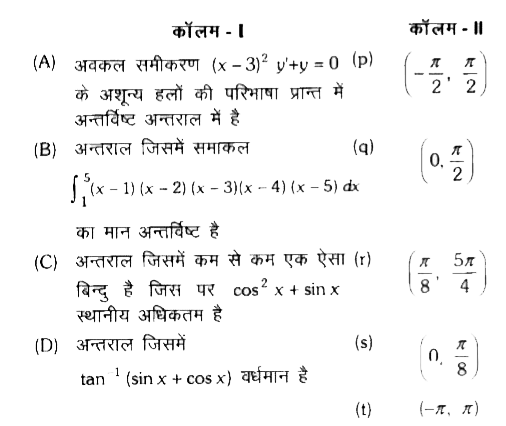यदि f(x)=ex,g(x)=sin−1x और h(x)=f(g(x)), तब h'(x)/h(x)=
esin−1x
1/√1−x2
sin−1x
1/(1−x2)
The correct Answer is:B
Step by step video, text & image solution for यदि f(x)=e^(x),g(x)=sin^(-1)x और h(x)=f(g(x)), तब h'(x)//h(x)= by Maths experts to help you in doubts & scoring excellent marks in Class 12 exams.
Topper's Solved these Questions
- BOOK - ERRORLESS HINDICHAPTER - अवकलन तथा अवकलज के अनुप्रयोगEXERCISE - MULTIPLE CHOICE QUESTIONS(प्रतिस्थानपन द्वारा अवकलन, उच्च कोटि के अवकलज )92videos
अवकलन तथा अवकलज के अनुप्रयोग
- BOOK - ERRORLESS HINDICHAPTER - अवकलन तथा अवकलज के अनुप्रयोगEXERCISE - MULTIPLE CHOICE QUESTIONS (आंशिक अवकलन )10videos
अवकलन तथा अवकलज के अनुप्रयोग
- BOOK - ERRORLESS HINDICHAPTER - अवकलन तथा अवकलज के अनुप्रयोगEXERCISE - MULTIPLE CHOICE QUESTIONS (एक बिन्दु पर अवकलज,मानक अवकलज)186videos
अवकलन तथा अवकलज के अनुप्रयोग
- BOOK - ERRORLESS HINDICHAPTER - अवकल समीकरण EXERCISE - JEE Advanced ( Matrix Match type questions )3videos
अवकल समीकरण
- BOOK - ERRORLESS HINDICHAPTER - केन्द्रीय प्रवृत्ति के मापEXERCISE - Jee Advanced (Reasoning )2videos
केन्द्रीय प्रवृत्ति के माप
Similar Questions
यदि y=sin(2sin−1x), तो dydx=
01:26View Solutionयदि u=log(x3+y3+z3−3xyz) तो (ϑuϑx+ϑuϑy+ϑuϑz)(x+y+z)=
04:43View Solution2f(x)=f'(x) एवं f(0)=3, तब f(2)=
02:08View Solution 02:50View Solution
02:50View Solutionकथन - 1 : प्रथम n सम धन पूर्णांकों का प्रसरण n2−14 है।
कथन - 2 : प्रथम n धन पूर्णाको का योगफल n(n+1)2 और प्रथम n धन पूर्णांको के वर्गों का योगफल n(n+1)(2n+1)6 है।02:18View Solutionlet f(x)=e^(x),g(x)=sin^(-1)x and h(x)=f(g(x)) th e n fin d (h'(x))/(h(x))
02:36View SolutionIf f(x), g(x), h(x) are polynomials of three degree, then phi(x)=|(f'(x),g'(x),h'(x)), (f''(x),g''(x),h''(x)), (f'''(x),g'''(x),h'''(x))| is a polynomial of degree (where f^n (x) represents nth derivative of f(x))
01:09View SolutionIf f(x)=x−1,g(x)=3x,andh(x)=5x , then f−1(g(h(5)))=
06:30View SolutionIf f(x) be a function such that f(−x)=−f(x),g(x) be a function such that g(−x)=−g(x) and h(x) be a function such that h(−x)=h(x), then choose the correct statement:
I. h(f(g(−x)))=−h(f(g(x)))
II. f(g(h(−x)))=f(g(h(x)))
III. g(f(−x))=g(f(x))02:34View SolutionIf f(x)=ex,g(x)=Sin−1xandh(x)=f(g(x)), then h'(x)h(x)=
View Solutionमाना f दो बार अवकलनीय फलन इस प्रकार है, कि f''(x)=−f(x) और f'(x)=g(x)
h(x)=[f(x)]2+[g(x)]2
यदि h(5) =11 हो, तो h(10) ज्ञात कीजिए |01:20View SolutionIf f(x)=4x−5,g(x)=x2andh(x)=1x, then f(g(h(x))) is :
02:22View Solutionf(x)=1−h(x),g(x)=1−k(x),h(x)=f(x)+1
f(x)=g(x)+1,k(x)=j(x)+1
Find the value of f(f(x))+k(g(x))h(k(x))+f(j(x)):07:17View SolutionIf f(x)=(g(x))+g(−x)2+2[h(x)+h(−x)]−1 where g and h are differentiable functions then f'(0)
03:13View Solutionयदि f(x)=ex,g(x)=sin−1x और h(x)=f(g(x)), तब h'(x)/h(x)=
02:21View Solution

